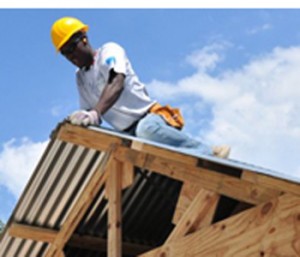IOM’s Earthquake Response Creates Skills and Jobs to Drive the Recovery in Haiti
Tuesday, January 10th, 2012 6:38:52 by Fayyaz Yaseen
IOM’s Earthquake Response Creates Skills and Jobs to Drive the Recovery in Haiti
Two years after the earthquake devastated Haiti, the International Organization for Migration is helping the Government of Haiti reduce the remaining population in tent cities, while laying the foundation for jobs-led economic
growth to rebuild the country.
Haiti has been witness to one of the largest humanitarian endeavours ever mounted and the most destructive urban disaster in recent history. In partnership with the government of Haiti, international and national partners, IOM is active on many fronts providing
relief and solutions for a crippled society that is only now getting off its knees.
The results of all this work are encouraging:
From a peak of 1.5 million people in July 2010, the number of camp residents has dropped by 66 per cent to 515,819 individuals living in 707 identified IDP sites across the earthquake affected areas. Many have found better housing with the help of the international
community.
Two years after the earthquake, more than 100,000 transitional-shelters have been built, housing some 420,000 individuals or the equivalent of the entire population of the US city of Atlanta.
A multitude of initiatives are underway, including the government-led "16/6 project", which provides rental subsidies to empty camps and public works to rehabilitate devastated neighbourhoods.
More than a million tarpaulins were distributed (the equivalent of 21.3 square kilometres or all of central Paris)
Before 12 January 2010, Haiti was already one of the poorest countries in the world. Some 75 per cent of Haitians lived on less than two dollars a day and 47 per cent of them did not have access to health care.
This disaster highlighted decades of chronic political instability and lack of economic opportunity that had left many Haitians in abject poverty. The quake also killed indiscriminately, hitting the government infrastructure particularly hard.
Significant steps have been taken on the road to recovery, but structural challenges remain, most notably economic development as the country turns the corner from emergency aid to sustainable recovery. IOM is at the forefront of those efforts.
IOM was present in Haiti, long before the earthquake killed so many and devastated the capital Port-au-Prince and other densely populated urban areas. The displacement of 1.5 million people delivered a devastating shock that stalled the economy. In the massive
aid effort that followed, IOM helped organize 1,500 camps whilst giving Haitian individuals and businesses the means to step forward and shoulder the reconstruction effort.
It engaged local contractors to build over 10,000 transitional shelters and as well as durable homes. It engaged small engineering firms to build seismic resistant schools and government buildings. Local contractors were also hired to build irrigation canals
to grow crops and also improved Haiti’s rural road networks, key to getting agricultural produce to market. They also brought improvements to public health systems in some of Haiti’s worst slums. Local contractors also developed the skills they need to grow
their businesses and create jobs.
"So much of our work is focused on the vital task of getting Haitian businesses, especially small, one-person operations, back on their feet," said Luca Dall’Oglio, IOM Chief of Mission in Haiti.
"Whether we contract masons to build houses safely, or engage small engineering firms to rebuild infrastructure, we are laying the foundations of a vibrant Haitian economy where jobs take the place of humanitarian aid," he added.
Much of IOM’s work has focused on protecting the homeless forced to live in camps and helping them to find long term housing solutions. The number of camp residents has dropped by 66 per cent today, a percentage that is in constant decline. As people depart
the camps, many with a year’s rental subsidy, they are well placed to both acquire new skills and get jobs as communities are being rebuilt.
Two of the capital’s most prominent camps, in two public parks, Place Boyer and Place St Pierre, closed in recent weeks with IOM help, under the government’s "16/6 project".
The parks now provide badly needed recreation space for the overcrowded city. Former camp residents have also found jobs as the process of rebuilding houses and infrastructure in earthquake-damaged communities picks up speed.
Pressure on the congested capital has been relieved by decentralization. In cooperation with the Haitian social housing authority EPPLS, IOM recently completed an inner-city housing project in the southern city of Les Cayes. Among the beneficiaries are handicap
victims from Port-au-Prince. These new owners pay small mortgage instalments every month and are showing pride in ownership.
In Port-au-Prince meanwhile, a team of over 200 Haitians are busy mapping the footprint of each and every house in the parts of the city devastated by the quake. This fine-grained work, under IOM’s guidance, is essential to the rebuilding process. This work
also gives clarity on property ownership, the absence of which remains an impediment to development.
"IOM remains committed to Haiti and the Haitian people," said William Lacy Swing IOM’s Director General, "and we are there for the long haul. I am also delighted that President Martelly’s government is working closely with IOM and the humanitarian community
as the pace of improvement shows."
Short URL: https://www.newspakistan.pk/?p=8757

















